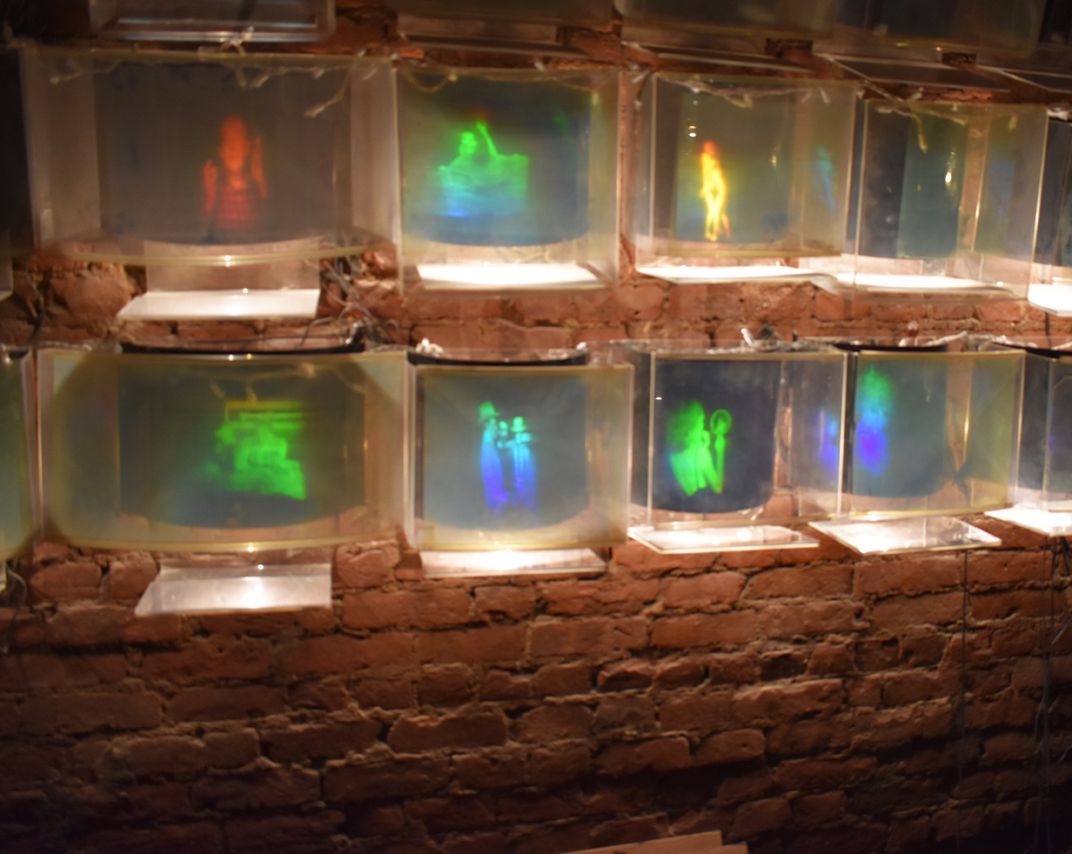Explore the Subterranean Chambers of the World’s Longest-Operating Hologram Gallery
Dr. Laser has been creating holograms inside his NYC laboratory since the 1970s
:focal(800x119:801x120)/https://tf-cmsv2-smithsonianmag-media.s3.amazonaws.com/filer/c4/8a/c48a34ae-deba-4fb2-a51a-3f13d01cf98c/mosque_for_slider.jpg)
Visiting Jason Sapan’s underground laser laboratory at the Holographic Studios in New York City is similar to what I would expect a visit to Doc Brown’s lab in the movie “Back to the Future” would be like. “Or ‘Silence of the Lambs’,” Sapan jokes as we descend a dark staircase that runs between the studios’ gallery and lab.
Since 1979 Sapan (aka Dr. Laser) has been creating holograms at this space in midtown Manhattan, a former blacksmith’s forge. Today it’s known as the world’s longest-operating gallery of holography. Sapan first got into holography after his father introduced him to the technology at a young age. His childhood home was inevitably the only one on the block containing a laser, and by the 1960s he was creating laser displays at the World's Fair. Over the years Sapan has found a way to merge science with art, proudly displaying his creations for the public to see. Sapan pays the bills by creating holograms for corporate clients like Goodyear and TAG Heuer, but his gallery is also filled with experimental portraits, including one of Andy Warhol flipping through a newspaper, which he created in 1977. He also offers guided private and group tours of the space, which include a visit to one of the world’s largest collections of motion image holograms plus a demonstration inside Sapan’s lab. That's where we’re currently headed.
I make my way through the subterranean labyrinth of passageways, guided only by Sapan’s voice and the dim glow of a green photographic safelights that reveal piles of dusty gadgets and gizmos whose likenesses he's transformed into holograms over the years. Once inside the lab, Sapan lights a cigarette and blows the smoke into the eerie expanse, revealing a red laser beam that has been split into two. To create a hologram, he uses mirrors to reflect the lasers off of an object and a holographic plate, like a piece of glass or plastic, capturing a three-dimensional image.
"The fact that holograms are fully three dimensional, beyond other types of stereoscopic illusions, makes it possible to actually look around them and partially rotate an image," Sapan tells Smithsonian.com. "Some holograms are made from a series of sequential holographic exposures that are stacked together. In this case, they can have full animation like a motion picture.”
Gesturing to the laser, Sapan explains how holograms are actually made. “When the light wave hits the object, what you don’t think about is that it’s leaving a physical, three-dimensional impression on the front of the wave,” he says. “This is what holography is about. Rather than worrying about our two eyes, what we’re doing is an alternate idea in photography. In a regular camera there is a lens that focuses light on a photosensitive medium like film. With holography we’ve taken away the lens, and we’re capturing the echo. When the light hits [an object], it takes its shape, and we’re photographing the shape of light waves."
Sapan likens the idea to making cupcakes. “You take a muffin pan, you pour in the batter, put it in the oven, and then pull it out. The cakes have taken the shape of the cups in the muffin pan. When you take the pan and... turn it over they’re not cups, they’re bumps and are inside out. It’s the same idea with holography.”
But unlike a cupcake, a hologram has longevity, which can be seen in the dozens of holograms that line the walls of the upstairs gallery. The majority of the pieces are his creations but several are ones he has acquired over the years from other holographers. Going through the collection I can’t help but ooh and ahh in amazement as each mind-bending image jumps out at me. Michael Jackson peers out at me in a vibrant mix of neon greens, blues and yellows. A skeleton dangles near another showcasing a lion mid roar. Simply put, what Sapan is doing in his laboratory is pure magic, which I tell him. Grinning he agrees, “That’s what science really is. It’s magic with knowledge.”
Planning Your Next Trip?
Explore great travel deals
Smithsonian magazine participates in affiliate link advertising programs. If you purchase an item through these links, we receive a commission.

/https://tf-cmsv2-smithsonianmag-media.s3.amazonaws.com/filer/ee/cf/eecfa123-0c68-49b0-a750-9ec4bc90a9b3/dsc_0064_1.jpg)
/https://tf-cmsv2-smithsonianmag-media.s3.amazonaws.com/filer/1f/85/1f856c4c-4096-4968-afd7-e301b0ec53f5/dsc_0066.jpg)
/https://tf-cmsv2-smithsonianmag-media.s3.amazonaws.com/filer/c1/91/c191b887-e14a-4dec-b846-e3719bb33fb2/img_20170427_192901291_hdr.jpg)
/https://tf-cmsv2-smithsonianmag-media.s3.amazonaws.com/filer/93/62/93629979-75a0-4da5-9705-042776ebc647/skeleton.jpg)